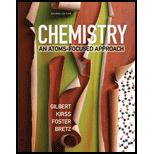
To find:
The numbers of moles of Na+ ions are there in 1 mole of the given compounds.
Answer to Problem 2.72QA
Solution:
a)
b)
c)
d)
Explanation of Solution
Calculations:
A mole is the SI unit of amount chemical substance. When writing units, it is written as “mol”.
a)
We can write the dissociation of NaCl from Na+ and Cl- as follows,
As from the equation we can easily determine the mole to mole ratio as here the mole ratio between NaCl and Na+ is
So, now we have the mole to mole ratio and moles of NaCl, so we can calculate the moles of Na+ by using dimensional analysis as below,
So,
b)
The dissociation of Na2SO4 from Na+ and SO42- can be given as below;
From the given balanced equation, the mole to mole ratio between Na2SO4 and Na+ is
So, by using dimensional analysis, we can calculate the moles of Na+ present in 1 mol of Na2SO4 as follows:
So,
c)
The dissociation of Na3PO4 from Fe and OH- can be given as below
From the given balanced equation, the mole to mole ratio between Na3PO4 and Na+ is
So, by using dimensional analysis, we can calculate the moles of Na+ present in
So,
d)
The dissociation of NaNO3 from Na+ and NO3-can be given as below.
From the given balanced equation, the mole to mole ratio between NaNO3 and Na+ is
So, by using dimensional analysis, we can calculate the moles of Na+ present in 1 mol of NaNO3 as follows:
So,
Conclusion:
We have calculated the number of moles of Na+ ions from the mole of given compounds and mole ratio.
Want to see more full solutions like this?
Chapter 2 Solutions
CHEMISTRY:ATOMS-FOCUSED..-ACCESS
 ChemistryChemistryISBN:9781305957404Author:Steven S. Zumdahl, Susan A. Zumdahl, Donald J. DeCostePublisher:Cengage Learning
ChemistryChemistryISBN:9781305957404Author:Steven S. Zumdahl, Susan A. Zumdahl, Donald J. DeCostePublisher:Cengage Learning ChemistryChemistryISBN:9781259911156Author:Raymond Chang Dr., Jason Overby ProfessorPublisher:McGraw-Hill Education
ChemistryChemistryISBN:9781259911156Author:Raymond Chang Dr., Jason Overby ProfessorPublisher:McGraw-Hill Education Principles of Instrumental AnalysisChemistryISBN:9781305577213Author:Douglas A. Skoog, F. James Holler, Stanley R. CrouchPublisher:Cengage Learning
Principles of Instrumental AnalysisChemistryISBN:9781305577213Author:Douglas A. Skoog, F. James Holler, Stanley R. CrouchPublisher:Cengage Learning Organic ChemistryChemistryISBN:9780078021558Author:Janice Gorzynski Smith Dr.Publisher:McGraw-Hill Education
Organic ChemistryChemistryISBN:9780078021558Author:Janice Gorzynski Smith Dr.Publisher:McGraw-Hill Education Chemistry: Principles and ReactionsChemistryISBN:9781305079373Author:William L. Masterton, Cecile N. HurleyPublisher:Cengage Learning
Chemistry: Principles and ReactionsChemistryISBN:9781305079373Author:William L. Masterton, Cecile N. HurleyPublisher:Cengage Learning Elementary Principles of Chemical Processes, Bind...ChemistryISBN:9781118431221Author:Richard M. Felder, Ronald W. Rousseau, Lisa G. BullardPublisher:WILEY
Elementary Principles of Chemical Processes, Bind...ChemistryISBN:9781118431221Author:Richard M. Felder, Ronald W. Rousseau, Lisa G. BullardPublisher:WILEY





